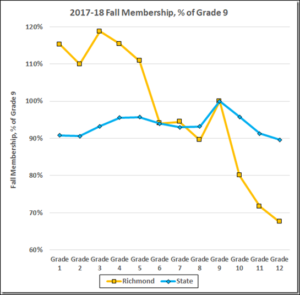
Virginia is notorious for its hostility toward charter schools. In the Old Dominion, charter schools must be approved by local school boards, which see educational alternatives as a threat rather than a potential blessing. Virginia has a grand total of eight charter schools, compared to 88 in New Jersey, a state with comparable school enrollment.
Among the commonly cited reasons for opposing charter schools is that they siphon away money from non-chartered public schools. The questionable assumption here is that existing schools can do a better job with the money than the charter schools can.
In the City of Richmond, which has the worst schools in the entire state (excepting possibly Petersburg), the School Board has permitted two charter schools, including one for kids with cognitive disabilities. According to the Richmond Times-Dispatch, a strong majority of school board members opposes creation of any more.
“In order to deliver on the promise of the American dream, we must aim for a public education system where every school is a good school,” said Kenya Gibson, who represents the city’s 3rd District, when running for School Board last year. “Corporate reforms, including the charter industry, are antithetical to this goal.”
Here’s a question for Gibson and others who oppose charter schools: Which drains more resources from Richmond Public Schools — a couple of charter schools or a school system that is so atrociously bad that every parent who can afford to do so sends their kids to private school or moves to a neighboring county?
The chart above, created by John Butcher of Cranky’s Blog fame, shows how enrollment remains strong in elementary schools, nine of which meet the benchmark for accreditation on the reading tests. Then in middle schools, educational attainment plummets — and, not surprisingly, so does enrollment. Each student who leaves represents the loss of thousands of dollars in state funds. How much money is the school district bleeding because of this exodus?
What if creating a charter middle school helped reverse plummeting enrollment and brought more money into the school district? When you have the worst schools and worst academic attainment in the entire state, isn’t it time to try something new?

Leave a Reply
You must be logged in to post a comment.